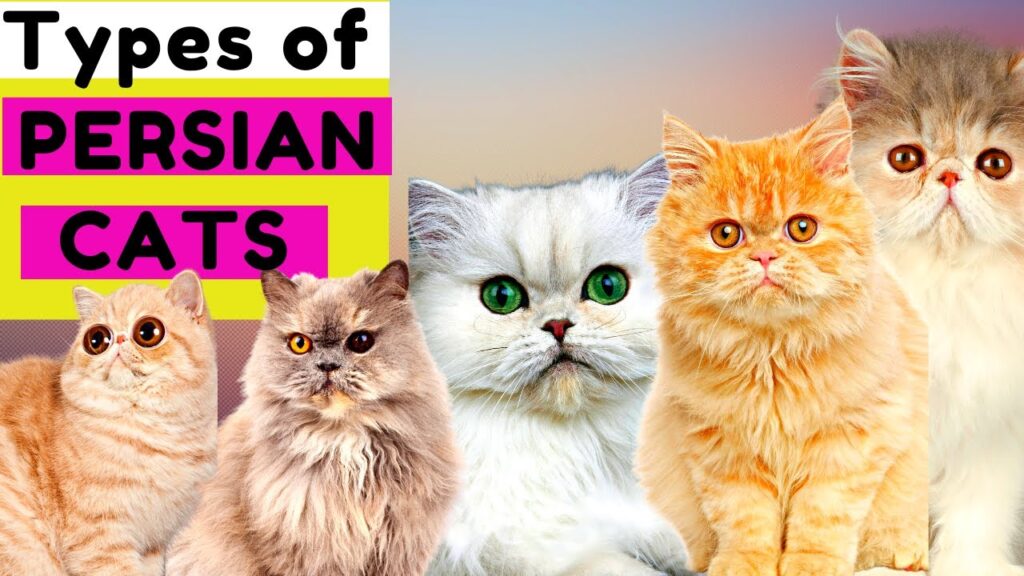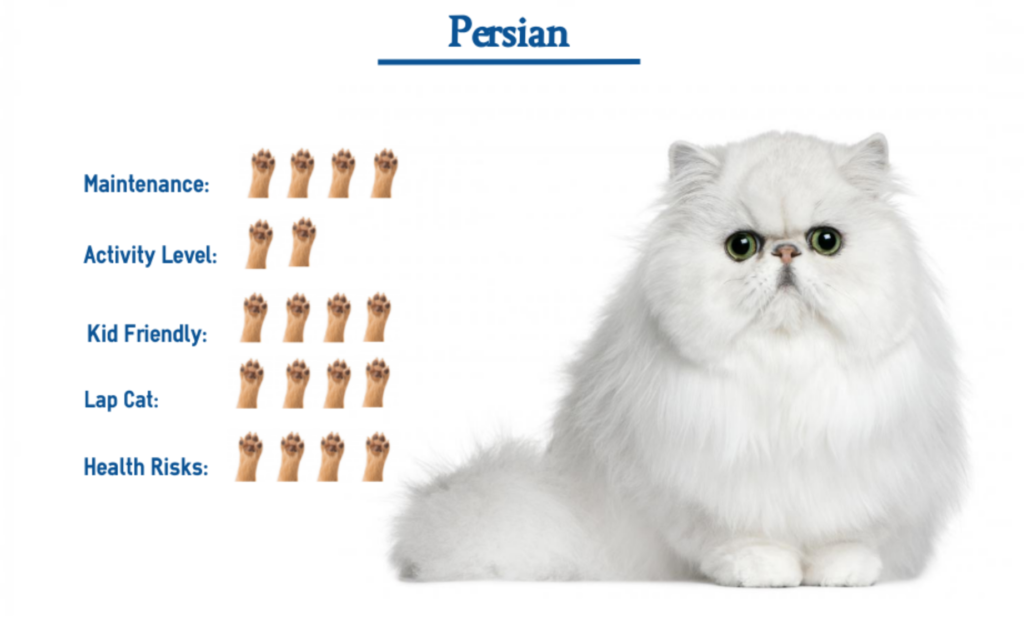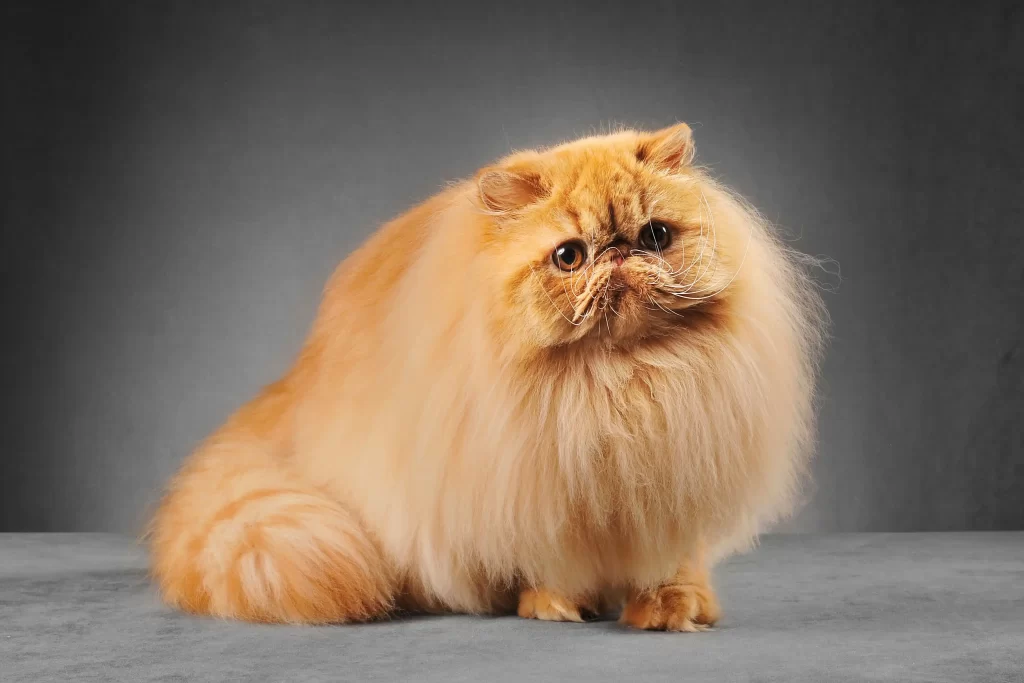Persian cats are known for their luxurious coats and gentle nature. In this article, you will learn about the different breeds of Persian cats, from the popular doll-faced Persians to the exotic-looking extreme Persians. We will explore their unique characteristics, grooming needs, and common health issues. By the end of this article, you will have a better understanding of these beautiful felines and be able to choose the perfect Persian cat breed for you.
Understanding the Different Breeds of Persian Cats
Persian cats are one of the most popular and beloved cat breeds in the world. Known for their luxurious coats and sweet temperament, Persian cats have captured the hearts of cat lovers everywhere. In this article, we will take a deep dive into the history, physical characteristics, temperament, grooming and care, health issues, nutrition, training and exercise, living arrangements, finding a breeder, and preparing for the arrival of a Persian cat. So, if you’re considering getting a Persian cat or simply want to learn more about these beautiful felines, keep reading!
The History of Persian Cats
Origin of Persian Cats
Persian cats have a long and rich history that dates back centuries. Although the exact origin of the breed is uncertain, there are several theories about how Persian cats came to be. One theory suggests that they originated in Persia (modern-day Iran) and were brought to Europe by Phoenician traders. Another theory suggests that they were brought to Persia by the Romans. Regardless of their origin, it is widely accepted that Persian cats were selectively bred for their unique traits and appearance.
Popularity over the years
Persian cats gained popularity in the late 19th century and have remained a favorite among cat enthusiasts ever since. Their elegant appearance and calm temperament make them highly desirable pets. Over the years, Persian cats have been featured in various cat shows and have won numerous awards for their beauty and grace. Their popularity has only grown with time, and they are now one of the most sought-after cat breeds worldwide.

Physical Characteristics of Persian Cats
Distinctive Features of Persian Cats
Persian cats are known for their distinct appearance and unique features. They have a round face with a flat nose and large, expressive eyes. Their heads are round, and they have small, tufted ears. Persian cats also have a sturdy body with a broad chest and short, thick legs. One of their most notable features is their long, thick coat, which comes in a variety of colors and patterns.
Coat Colors and Patterns
The coat of a Persian cat is undoubtedly one of its most striking features. Persian cats come in a wide range of coat colors and patterns, including solid colors, tabby, tortoiseshell, calico, and bi-color. The most common coat colors are white, black, blue, red, cream, and silver. The patterns can range from classic tabby to colorpoint, smoke, and shaded. Each Persian cat has its unique coat color and pattern, adding to their individual beauty and charm.
Facial Structure
The facial structure of Persian cats is one of their defining characteristics. Their flat noses, round faces, and large eyes give them an adorable and innocent expression. However, these features also come with some potential health concerns. The flat face of Persian cats can cause issues with their breathing and tear ducts, which we will explore further in the health issues section.
Temperament and Personality of Persian Cats
Gentle and Calm Nature
One of the reasons Persian cats are so beloved is their gentle and calm nature. They are known for being laid-back, affectionate, and easygoing. Persian cats are generally not as active or playful as some other breeds, preferring to lounge and observe their surroundings. Their calm demeanor makes them great companions for people who appreciate a more relaxed and serene environment.
Socialization and Behavior
Although Persian cats have a calm nature, they still require proper socialization from an early age. It is essential to expose them to different people, pets, and environments to ensure they grow up to be well-adjusted and friendly cats. Persian cats can be a bit reserved with strangers but are usually devoted and loyal to their families. They love to be pampered and enjoy gentle attention and affection.
Interacting with Other Pets
Persian cats generally get along well with other pets, especially if they are introduced properly and given time to adjust. They are not typically aggressive or territorial and can coexist peacefully with dogs, other cats, and even small animals like rabbits or guinea pigs. However, it is crucial to supervise their interactions initially and provide each pet with their own space and resources to avoid potential conflicts.

Grooming and Care for Persian Cats
Maintenance of Long Coats
One of the most distinctive features of Persian cats is their long, luxurious coat. However, this beautiful coat requires regular maintenance and grooming to keep it healthy and free from mats and tangles. Daily brushing is essential to prevent hairballs, minimize shedding, and maintain the coat’s beauty. A quality brush specifically designed for Persian cats, such as a long-toothed comb or bristle brush, is recommended.
Bathing and Brushing
In addition to regular brushing, Persian cats also require occasional baths to keep their coats clean and free of dirt and oils. It is essential to use a gentle cat shampoo that is specifically formulated for long-haired breeds. After bathing, thorough drying is crucial to prevent skin issues. Regular ear cleaning, nail trimming, and dental care are also important parts of a Persian cat’s grooming routine.
Eye and Ear Care
Persian cats are prone to eye and ear issues due to their facial structure and long hair around their faces. Periodic eye cleaning with a soft, damp cloth or specialized eye wipes is necessary to prevent tear staining and eye infections. Care should be taken to gently clean the corners of the eyes to remove any discharge. The ears should also be checked regularly for wax build-up and cleaned with a veterinarian-recommended ear cleaner.
Health Issues and Concerns of Persian Cats
Common Health Problems
While Persian cats are generally healthy and long-lived, they are predisposed to certain health issues. Some of the common health problems in Persian cats include polycystic kidney disease (PKD), hypertrophic cardiomyopathy (HCM), progressive retinal atrophy (PRA), and dental issues. Regular veterinary check-ups and health screenings are crucial to detect and manage any potential health issues early on.
Breathing and Respiratory Issues
Due to their flat facial structure, Persian cats are more prone to breathing and respiratory issues compared to other breeds. They can experience snoring, wheezing, and difficulty breathing, especially in hot and humid environments. It is essential to provide them with a well-ventilated and cool living space to help alleviate these issues. In severe cases, surgical intervention may be necessary to improve their breathing.
Dental Care
Persian cats are also prone to dental problems, such as gum disease, tooth decay, and tartar buildup. Regular dental care is essential to maintain their oral health. This includes regular teeth brushing with a cat-specific toothpaste, feeding dental-friendly food, and providing dental treats or toys that can help reduce plaque and tartar buildup. Regular dental cleanings by a veterinarian may also be necessary.

Nutrition and Feeding for Persian Cats
Choosing the Right Diet
Proper nutrition is crucial for the overall health and well-being of a Persian cat. It is important to choose a high-quality cat food that is specifically formulated for long-haired breeds or for cats with specific dietary requirements. Look for a balanced diet that provides all the necessary nutrients, including proteins, fats, carbohydrates, vitamins, and minerals. Avoid feeding your Persian cat an excessive amount of treats or human food, as this can lead to obesity and other health issues.
Special Dietary Requirements
Some Persian cats may have special dietary requirements due to specific health conditions or sensitivities. For example, cats with kidney disease may require a low-protein diet, while cats with food allergies or intolerances may need a specialized hypoallergenic diet. It is important to consult with a veterinarian to determine the best diet for your Persian cat based on their individual needs.
Feeding Schedule
Establishing a regular feeding schedule is important for Persian cats to maintain a healthy weight and prevent overeating. It is recommended to divide their daily food intake into two or three meals throughout the day. Free-feeding should be avoided to prevent obesity and ensure proper portion control. Provide fresh water at all times and monitor their water intake, as some Persian cats may be prone to urinary issues.
Training and Exercise for Persian Cats
Basic Training Techniques
Persian cats are generally not as responsive to training commands as some other breeds, but they can still learn basic obedience and tricks with patience and positive reinforcement. Reward-based training techniques, such as using treats or praise, work best with Persian cats. Start with simple commands like “sit” or “come” and gradually build up to more advanced tricks.
Play and Exercise Needs
Persian cats are not particularly active or playful compared to some other breeds, but it is still important to provide them with mental and physical stimulation. Engage in interactive play sessions with toys, such as wand toys or puzzle toys, to keep them entertained and stimulated. Additionally, providing scratching posts, climbing trees, and perches can help satisfy their natural instincts and provide exercise opportunities.

Indoor Versus Outdoor Living for Persian Cats
Pros and Cons of Indoor Living
Persian cats are generally better suited for indoor living due to their calm nature and long coat. Indoor living provides them with a safe and controlled environment where they are protected from potential dangers, such as traffic, predators, and contagious diseases. However, it is important to create an enriching indoor environment that includes scratching posts, climbing opportunities, and interactive toys to prevent boredom and promote physical and mental well-being.
Creating an Enriching Environment
To ensure a happy and healthy life for your Persian cat, it is important to create an enriching environment that caters to their physical and psychological needs. Provide plenty of vertical spaces, such as cat trees or shelves, for climbing and perching. Set up scratching posts and provide a variety of toys to keep them mentally stimulated. Consider creating designated play areas and rotating toys to prevent boredom.
Finding a Persian Cat Breeder
Researching Reputable Breeders
When looking for a Persian cat breeder, it is important to do thorough research and ensure that they are reputable and ethical. Look for breeders who prioritize the health and well-being of their cats and follow responsible breeding practices. Ask for references, check online reviews and testimonials, and visit the breeder’s facility if possible. A reputable breeder will be transparent and knowledgeable about the breed and will provide proper documentation, such as health certificates and pedigree information.
Health and Genetic Testing
Reputable Persian cat breeders prioritize the health of their cats and conduct various health and genetic tests to ensure the well-being of their kittens. Some of the common tests for Persian cats include PKD screening, HCM screenings, and DNA testing for genetic disorders. It is important to ask the breeder about the health testing they perform on their cats and kittens and request to see the test results before committing to a purchase.

Preparing for a Persian Cat’s Arrival
Essential Supplies and Equipment
Before bringing a Persian cat home, it is important to gather all the necessary supplies and equipment to ensure their comfort and well-being. Some of the essential items you will need include a litter box and litter, food and water bowls, high-quality cat food, a scratching post, bedding or blankets, grooming tools, toys, and a carrier for transportation. Prepare a safe and quiet space for them to retreat to, especially during their initial adjustment period.
Creating a Safe Space
To help your Persian cat feel safe and secure in their new environment, it is important to create a designated safe space for them. This can be a quiet room or area of your home where they can retreat to when they need privacy or a break from noise and activity. Provide a comfortable bed or blanket, their litter box, food and water bowls, and some of their favorite toys in this space. Gradually introduce them to the rest of your home once they feel comfortable and settled.
Introducing a Persian Cat to Your Home
Gradual Introduction to New Surroundings
When bringing a Persian cat home, it is important to introduce them to their new surroundings gradually. Start by confining them to a small area, such as a bathroom or spare room, for the first few days. Allow them to explore this area and become familiar with their litter box, food and water bowls, and bedding. Once they seem comfortable, gradually open up more areas of your home for them to explore and settle in.
Establishing Routines
Establishing routines and consistent daily schedules is important for Persian cats as they thrive on stability and predictability. Set specific times for feeding, playtime, grooming, and rest. Regularly interact and spend time with your Persian cat to form a strong bond and build trust. Provide them with plenty of positive attention and affection to help them feel loved and secure in their new home.
Litter Box Training for Persian Cats
Choosing and Placing the Litter Box
Litter box training is an essential part of acclimating your Persian cat to their new home. Choose a litter box that is large enough for them to comfortably use and has low sides for easy access. Place the litter box in a quiet and easily accessible area, away from their food and water bowls. Multiple litter boxes may be necessary, especially in larger homes, to ensure easy access and prevent accidents.
Positive Reinforcement Training
To litter box train your Persian cat, start by placing them in the litter box after meals or naps. Gently scratch the litter with their paw to demonstrate the purpose of the box. If they use the litter box, praise and reward them with treats or gentle petting. If they have accidents outside of the litter box, avoid scolding or punishing them as this can create negative associations. Instead, clean up the mess and ensure the litter box is clean and easily accessible.
Persian Cats in Different Environments
Persian Cats in Apartments
Persian cats can adapt well to apartment living due to their calm and low-energy nature. However, it is important to provide them with sufficient mental and physical stimulation, as well as create an enriching environment. Ensure they have access to vertical spaces, scratching posts, toys, and a comfortable resting area. Consider using interactive puzzle toys or providing a window perch for them to observe the outside world.
Persian Cats in Families with Children
Persian cats can be a great choice for families with children, as they are generally patient and tolerant. However, it is important to teach children how to properly interact with a cat and respect their boundaries. Educate children about gentle handling, avoiding pulling their hair or tail, and understanding when the cat needs space. Supervise interactions between children and Persian cats, especially younger children who may not fully understand proper cat handling.
Persian Cats in Single-Pet Homes
Persian cats can thrive in single-pet homes, as they enjoy being the center of attention. They form strong bonds with their owners and can provide companionship and love. However, it is important to ensure they receive sufficient mental and physical stimulation, as they may become bored or lonely if left alone for long periods. Provide interactive toys, play sessions, and regular affection to keep them happy and content.
Conclusion
Persian cats are truly one-of-a-kind felines. With their stunning appearance, calm temperament, and loving nature, they make wonderful companions for cat lovers of all kinds. Whether you choose to bring a Persian cat into your home or simply want to learn more about this beloved breed, understanding their history, physical characteristics, temperament, grooming and care, health issues, nutrition, training and exercise, living arrangements, finding a breeder, and preparing for their arrival is vital. By providing them with the love, care, and attention they deserve, you can enjoy a lifelong bond with your Persian cat.
-
Q: Are Persian cats good with children?
-
A: Persian cats can be great companions for children. They are known for their gentle and patient nature, which makes them well-suited for households with kids. However, it is important to teach children how to interact properly with a cat and to supervise their interactions to ensure the safety and well-being of both the children and the cat.
-
Q: How often should I groom my Persian cat?
-
A: Persian cats require regular grooming to keep their long coats healthy and free from mats. Daily brushing is recommended to prevent tangles and hairballs. Additionally, Persian cats may need occasional baths to keep their coats clean. It is important to establish a grooming routine early on to help your Persian cat become accustomed to the process.
-
Q: Do Persian cats have any specific health issues?
-
A: Persian cats are prone to certain health issues, including polycystic kidney disease (PKD), hypertrophic cardiomyopathy (HCM), dental problems, and respiratory issues due to their flat facial structure. Regular veterinary check-ups and health screenings are important to detect and manage any potential health issues early on.
-
Q: Can Persian cats live in apartments?
-
A: Yes, Persian cats can adapt well to apartment living. Their calm and low-energy nature makes them well-suited for indoor living. However, it is important to provide them with an enriching environment that includes vertical spaces, scratching posts, and interactive toys to prevent boredom and provide mental and physical stimulation.
-
Q: How should I introduce a Persian cat to my home?
-
A: When bringing a Persian cat home, it is important to introduce them to their new surroundings gradually. Start by confining them to a small area, such as a bathroom or spare room, for the first few days. Allow them to explore this area and become familiar with their litter box, food and water bowls, and bedding. Once they seem comfortable, gradually open up more areas of your home for them to explore and settle in.
-
Q: What is the lifespan of a Persian cat?
-
A: Persian cats have an average lifespan of around 12 to 16 years, but with proper care and a healthy lifestyle, they can live even longer. Regular veterinary check-ups, a balanced diet, and providing a safe and loving environment can help ensure a long and happy life for your Persian cat.
